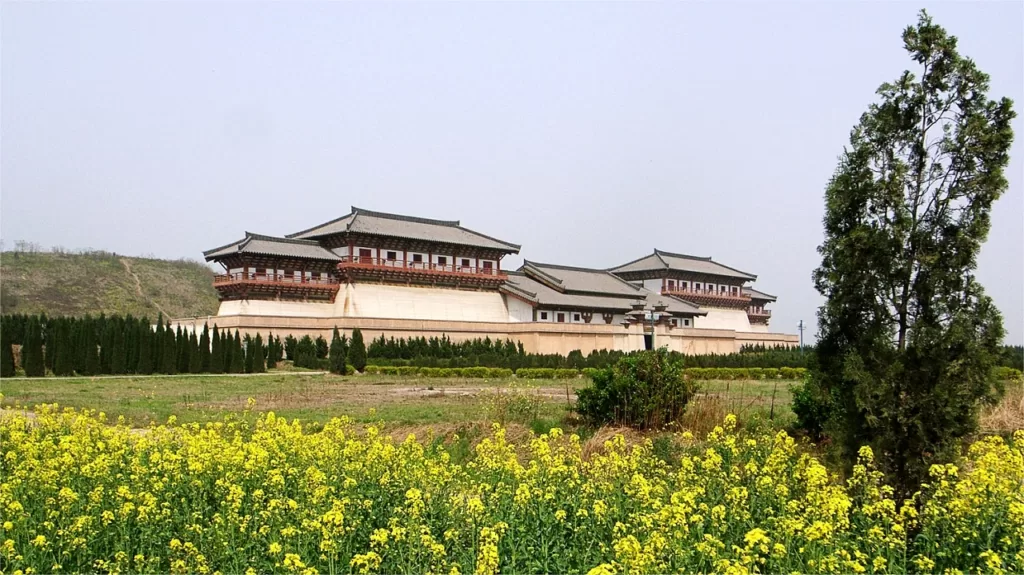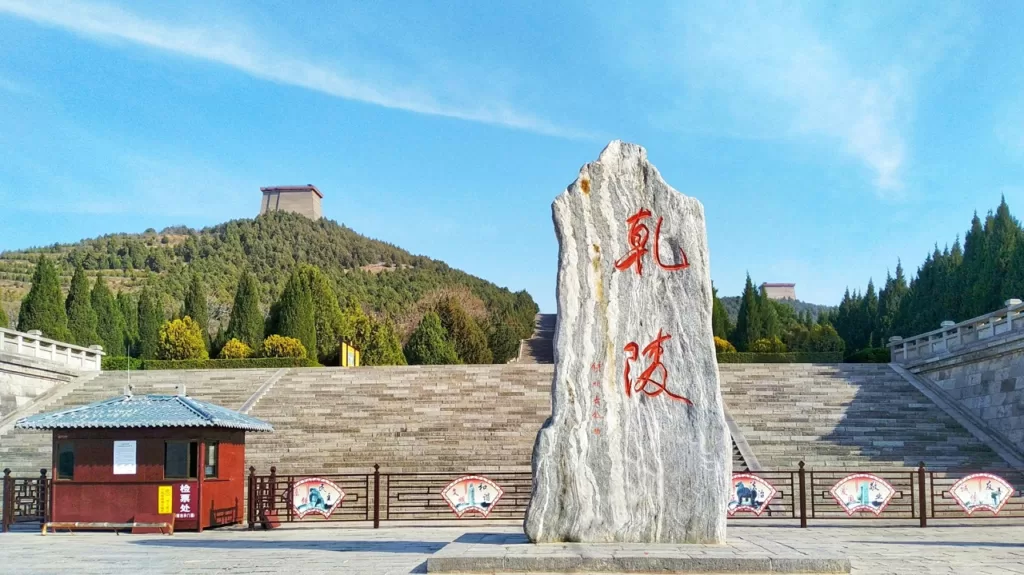The Maoling Mausoleum (茂陵) is the final resting place of Emperor Wu of Han, who ruled China from 141 BC to 87 BC. Located in Xingping, Xianyang city, Shaanxi province, the mausoleum is one of the largest and best-preserved imperial tombs from the Han dynasty.
Built over four years, the Maoling Mausoleum covers an area of over 46 hectares and is surrounded by a massive earthen wall that stretches for over 9 kilometers. Inside the mausoleum complex, there are a number of elaborate structures, including an underground palace, a series of burial chambers, and several smaller tombs for the emperor’s family members and servants.
The underground palace is the most impressive feature of the Maoling Mausoleum, with a central burial chamber that is over 28 meters long and 4.5 meters high. The walls of the chamber are lined with intricate carvings and paintings depicting scenes from the emperor’s life and the afterlife.
Today, the Maoling Mausoleum remains an important historical site and a popular tourist attraction, offering visitors a glimpse into the grandeur and sophistication of the Han dynasty.
Table of Contents
- Basic Information
- Location and Transportation
- Hilights of Maoling Mausoleum
- Vlog about Maoling Mausoleum
- Useful Tips Summarized from Reviews
- Other Mausoleums in Shaanxi
Basic Information
| Website | https://www.maoling.com/ |
| Estimated Length of Tour | Over 2 hours |
| Opening Hours | 8.30 – 18.00 (1st April – 31st October) 8.30 – 17.30 (1st November – 31st March) |
| Ticket Price | 75 RMB (1st April – 31st October) 55 RMB (1st November – 31st March) |
Location and Transportation
The Maoling Mausoleum is located in Xingping County, Xianyang City, about 80 kilometers northeast of Xi’an, the capital city of Shaanxi Province in China.
There are several ways to get to Maoling Mausoleum. The most convenient way is to take a taxi or hire a private car from Xi’an. The journey takes about 1.5 hours, depending on the traffic.
Alternatively, visitors can take a public bus from Xi’an to Xingping, and then transfer to a local bus or a taxi to reach the Maoling Mausoleum. The bus journey takes about 2 hours, and the local bus or taxi ride takes an additional 30 minutes to an hour.
For those who prefer to travel by train, there are several trains from Xi’an Railway Station to Xianyang East Railway Station, and then transfer to a local bus or taxi to reach the Maoling Mausoleum. The train journey takes about 20 minutes, and the local bus or taxi ride takes an additional 40 minutes. This should be the most cost-effective way.
Hilights of Maoling Mausoleum
Underground Palace

The Underground Palace of Maoling Mausoleum is an elaborate system of tunnels, corridors, chambers, and niches that leads to the burial chamber of Emperor Wu of Han. It covers an area of over 1,800 square meters, with a central chamber that is over 28 meters long and 4.5 meters high. The walls of the chamber are lined with intricate carvings and paintings that depict scenes from the emperor’s life and the afterlife. The palace is also home to a number of other chambers and niches, including a chamber for storing burial objects and a ritual hall for performing ceremonies.
Tomb Mound

The Tomb Mound of Maoling Mausoleum is a massive earthen mound that covers the burial chamber of Emperor Wu of Han. The mound is over 46 meters high and is surrounded by a moat and a massive outer wall that stretches for over 9 kilometers. The mound is designed to represent a mountain, with terraces and steps leading up to the top. At the center of the mound is the burial chamber, which is accessed through the Underground Palace. The Tomb Mound is an impressive engineering feat that demonstrates the Han dynasty’s mastery of construction and their reverence for their rulers.
Stone Sculptures

The Maoling Mausoleum is home to a large collection of stone sculptures that are remarkable for their artistry and detail. They include statues of warriors, horses, and mythical creatures, as well as carvings of plants and animals. The sculptures were created during the Han dynasty and are a testament to the era’s artistic achievements. The most impressive of these sculptures is the pair of stone horses that flank the entrance to the mausoleum complex. They are over 3 meters high and are adorned with intricate carvings that depict their muscular bodies and flowing manes.
Other Tombs

The Maoling Mausoleum complex contains several tombs in addition to the tomb of Emperor Wu of Han. These tombs are believed to be the final resting places of his family members, ministers, and officials. Among them are the tombs of Empress Wei, Emperor Wu’s first wife, General Weiqing and Huoqubing, the most renowned generals in Chinese History, and Prince FUling, Emepror Wu’s son.
Vlog about Maoling Mausoleum
Useful Tips Summarized from Reviews
Transportation: Getting to Maoling Mausoleum is convenient. You can take the Xi’an Metro directly to Xianyang West Station and then take a taxi to the mausoleum. However, it’s important to note that transportation back can be challenging. Taxis might be scarce, and even alternative options like three-wheeled vehicles, electric scooters, and bicycles might not be available. Be prepared for this possibility.
Feeding Fish: Within the mausoleum area, you’ll find well-fed fish. Fish food is available at a very affordable price, typically around 2 yuan per pack. If you’re interested, consider purchasing some to feed the fish during your visit.
Maoling Mausoleum Layout: The Maoling Mausoleum scenic area is divided into two main parts: the Maoling Mausoleum Museum and the actual Maoling Mausoleum site. There’s about a kilometer of walking distance between these two sections, so be prepared for some walking.







At 8:30 in the morning, take the subway line 1 to Xianyangxi, then take a taxi to Maoling. Arrive around 9:50, costing about 13 yuan. Visit Maoling and the nearby Maoling Museum, where two people spent 5 yuan for a trishaw ride. The visit lasted for about one and a half hours.